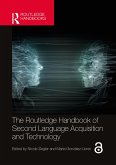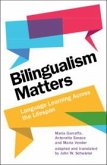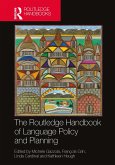Feedback in Second Language Writing
Herausgeber: Hyland, Fiona; Hyland, Ken
Feedback in Second Language Writing
Herausgeber: Hyland, Fiona; Hyland, Ken
- Broschiertes Buch
- Merkliste
- Auf die Merkliste
- Bewerten Bewerten
- Teilen
- Produkt teilen
- Produkterinnerung
- Produkterinnerung
Leading experts present a fully revised and updated introduction to feedback on second language writing with new content on technology, social media and language acquisition. The book is for upper undergraduate and postgraduate students, teachers and researchers in TESOL, applied linguistics and English for academic purposes (EAP).
Andere Kunden interessierten sich auch für
![Teaching Chinese as a Second Language Teaching Chinese as a Second Language]() Jane OrtonTeaching Chinese as a Second Language72,99 €
Jane OrtonTeaching Chinese as a Second Language72,99 €![The Routledge Handbook of Second Language Acquisition and Technology The Routledge Handbook of Second Language Acquisition and Technology]() The Routledge Handbook of Second Language Acquisition and Technology172,99 €
The Routledge Handbook of Second Language Acquisition and Technology172,99 €![Corpora in Applied Linguistics Corpora in Applied Linguistics]() Susan Hunston (University of Birmingham)Corpora in Applied Linguistics40,99 €
Susan Hunston (University of Birmingham)Corpora in Applied Linguistics40,99 €![Bilingualism Matters Bilingualism Matters]() Maria Garraffa (University of East Anglia)Bilingualism Matters22,99 €
Maria Garraffa (University of East Anglia)Bilingualism Matters22,99 €![Bilingualism Matters Bilingualism Matters]() Maria Garraffa (University of East Anglia)Bilingualism Matters81,99 €
Maria Garraffa (University of East Anglia)Bilingualism Matters81,99 €![How to do Discourse Analysis How to do Discourse Analysis]() James Paul GeeHow to do Discourse Analysis63,99 €
James Paul GeeHow to do Discourse Analysis63,99 €![The Routledge Handbook of Language Policy and Planning The Routledge Handbook of Language Policy and Planning]() The Routledge Handbook of Language Policy and Planning200,99 €
The Routledge Handbook of Language Policy and Planning200,99 €-
-
-
Leading experts present a fully revised and updated introduction to feedback on second language writing with new content on technology, social media and language acquisition. The book is for upper undergraduate and postgraduate students, teachers and researchers in TESOL, applied linguistics and English for academic purposes (EAP).
Hinweis: Dieser Artikel kann nur an eine deutsche Lieferadresse ausgeliefert werden.
Hinweis: Dieser Artikel kann nur an eine deutsche Lieferadresse ausgeliefert werden.
Produktdetails
- Produktdetails
- Cambridge Applied Linguistics
- Verlag: Cambridge University Press
- 2 Revised edition
- Seitenzahl: 332
- Erscheinungstermin: 30. Juni 2019
- Englisch
- Abmessung: 229mm x 152mm x 18mm
- Gewicht: 524g
- ISBN-13: 9781108439978
- ISBN-10: 1108439977
- Artikelnr.: 55174331
- Cambridge Applied Linguistics
- Verlag: Cambridge University Press
- 2 Revised edition
- Seitenzahl: 332
- Erscheinungstermin: 30. Juni 2019
- Englisch
- Abmessung: 229mm x 152mm x 18mm
- Gewicht: 524g
- ISBN-13: 9781108439978
- ISBN-10: 1108439977
- Artikelnr.: 55174331
Introduction. 1. Contexts and issues in feedback on L2 writing: setting the
scene Ken Hyland and Fiona Hyland; Part I. Situating Feedback:
Socio-cultural Dimensions: 2. Sociocultural theory: a framework for
understanding socio-cognitive dimensions of peer feedback Olga S. Villamil
and Maria C. M. de Guerrero; 3. Culture and peer feedback Guangwei Hu; 4.
Appropriation, ownership, and agency: negotiating teacher feedback in
academic settings Christine M. Tardy; Part II. Shaping Feedback: Delivery
and Focus Dimensions: 5. The intersection between SLA and feedback research
John Bitchener; 6. Does error feedback help L2 writers? Latest evidence on
the efficacy of written corrective feedback Dana Ferris and Kendon Kerzer;
7. Electronic resources for feedback Marie Stevenson and Aik Phakiti; 8.
Collaborative writing as peer feedback Neomy Storch; Part III. Negotiating
Feedback: Interpersonal and Interactional Dimensions: 9. Interpersonal
aspects of response: constructing and interpreting teacher written feedback
Ken Hyland and Fiona Hyland; 10. Fostering formative online forums:
feedback, dialogue and disciplinarity Ann Hewings and Caroline Coffin; 11.
Supervisory feedback: building writing scaffolds with doctoral students Sue
Starfield; 12. Reviewers' feedback on second language writers' submissions
to academic journals Brian Paltridge; Part IV. Engaging with Feedback:
Student Participation Dimensions: 13. Learner engagement with written
feedback from a socio-cognitive perspective Ye Han and Fiona Hyland; 14.
What messages do students take from teacher feedback? Ken Hyland; 15.
Students initiating feedback: the potential of social media Soobin Yim and
Mark Warschaeur; Index.
scene Ken Hyland and Fiona Hyland; Part I. Situating Feedback:
Socio-cultural Dimensions: 2. Sociocultural theory: a framework for
understanding socio-cognitive dimensions of peer feedback Olga S. Villamil
and Maria C. M. de Guerrero; 3. Culture and peer feedback Guangwei Hu; 4.
Appropriation, ownership, and agency: negotiating teacher feedback in
academic settings Christine M. Tardy; Part II. Shaping Feedback: Delivery
and Focus Dimensions: 5. The intersection between SLA and feedback research
John Bitchener; 6. Does error feedback help L2 writers? Latest evidence on
the efficacy of written corrective feedback Dana Ferris and Kendon Kerzer;
7. Electronic resources for feedback Marie Stevenson and Aik Phakiti; 8.
Collaborative writing as peer feedback Neomy Storch; Part III. Negotiating
Feedback: Interpersonal and Interactional Dimensions: 9. Interpersonal
aspects of response: constructing and interpreting teacher written feedback
Ken Hyland and Fiona Hyland; 10. Fostering formative online forums:
feedback, dialogue and disciplinarity Ann Hewings and Caroline Coffin; 11.
Supervisory feedback: building writing scaffolds with doctoral students Sue
Starfield; 12. Reviewers' feedback on second language writers' submissions
to academic journals Brian Paltridge; Part IV. Engaging with Feedback:
Student Participation Dimensions: 13. Learner engagement with written
feedback from a socio-cognitive perspective Ye Han and Fiona Hyland; 14.
What messages do students take from teacher feedback? Ken Hyland; 15.
Students initiating feedback: the potential of social media Soobin Yim and
Mark Warschaeur; Index.
Introduction. 1. Contexts and issues in feedback on L2 writing: setting the
scene Ken Hyland and Fiona Hyland; Part I. Situating Feedback:
Socio-cultural Dimensions: 2. Sociocultural theory: a framework for
understanding socio-cognitive dimensions of peer feedback Olga S. Villamil
and Maria C. M. de Guerrero; 3. Culture and peer feedback Guangwei Hu; 4.
Appropriation, ownership, and agency: negotiating teacher feedback in
academic settings Christine M. Tardy; Part II. Shaping Feedback: Delivery
and Focus Dimensions: 5. The intersection between SLA and feedback research
John Bitchener; 6. Does error feedback help L2 writers? Latest evidence on
the efficacy of written corrective feedback Dana Ferris and Kendon Kerzer;
7. Electronic resources for feedback Marie Stevenson and Aik Phakiti; 8.
Collaborative writing as peer feedback Neomy Storch; Part III. Negotiating
Feedback: Interpersonal and Interactional Dimensions: 9. Interpersonal
aspects of response: constructing and interpreting teacher written feedback
Ken Hyland and Fiona Hyland; 10. Fostering formative online forums:
feedback, dialogue and disciplinarity Ann Hewings and Caroline Coffin; 11.
Supervisory feedback: building writing scaffolds with doctoral students Sue
Starfield; 12. Reviewers' feedback on second language writers' submissions
to academic journals Brian Paltridge; Part IV. Engaging with Feedback:
Student Participation Dimensions: 13. Learner engagement with written
feedback from a socio-cognitive perspective Ye Han and Fiona Hyland; 14.
What messages do students take from teacher feedback? Ken Hyland; 15.
Students initiating feedback: the potential of social media Soobin Yim and
Mark Warschaeur; Index.
scene Ken Hyland and Fiona Hyland; Part I. Situating Feedback:
Socio-cultural Dimensions: 2. Sociocultural theory: a framework for
understanding socio-cognitive dimensions of peer feedback Olga S. Villamil
and Maria C. M. de Guerrero; 3. Culture and peer feedback Guangwei Hu; 4.
Appropriation, ownership, and agency: negotiating teacher feedback in
academic settings Christine M. Tardy; Part II. Shaping Feedback: Delivery
and Focus Dimensions: 5. The intersection between SLA and feedback research
John Bitchener; 6. Does error feedback help L2 writers? Latest evidence on
the efficacy of written corrective feedback Dana Ferris and Kendon Kerzer;
7. Electronic resources for feedback Marie Stevenson and Aik Phakiti; 8.
Collaborative writing as peer feedback Neomy Storch; Part III. Negotiating
Feedback: Interpersonal and Interactional Dimensions: 9. Interpersonal
aspects of response: constructing and interpreting teacher written feedback
Ken Hyland and Fiona Hyland; 10. Fostering formative online forums:
feedback, dialogue and disciplinarity Ann Hewings and Caroline Coffin; 11.
Supervisory feedback: building writing scaffolds with doctoral students Sue
Starfield; 12. Reviewers' feedback on second language writers' submissions
to academic journals Brian Paltridge; Part IV. Engaging with Feedback:
Student Participation Dimensions: 13. Learner engagement with written
feedback from a socio-cognitive perspective Ye Han and Fiona Hyland; 14.
What messages do students take from teacher feedback? Ken Hyland; 15.
Students initiating feedback: the potential of social media Soobin Yim and
Mark Warschaeur; Index.







